Development of a Spatial Synoptic Classification Scheme for East Africa with a Focus on Kenya
Abstract
:1. Introduction
2. Background
2.1. Climate of Kenya
2.2. Spatial Synoptic Classification
3. Materials and Methods
4. Results and Discussion
4.1. SSC Weather Type Characteristics in Kenya
4.2. Seasonality of the SSC Weather Types
4.3. Trends in SSC Weather Types
4.3.1. Interannual Variability
4.3.2. Seasonal Variability
5. Conclusions
Author Contributions
Funding
Data Availability Statement
Conflicts of Interest
References
- Yarnal, B. Synoptic Climatology in Environmental Analysis: A Primer. Belhaven Press: London, UK, 1993. [Google Scholar]
- Kalkstein, L.S.; Nichols, M.C.; Barthel, C.D.; Greene, J.S. A new spatial synoptic classification: Application to air-mass analysis. Int. J. Climatol. J. R. Meteorol. Soc. 1996, 16, 983–1004. [Google Scholar] [CrossRef]
- McGregor, G.; Walters, S.; Wordley, J. Daily hospital respiratory admissions and winter air mass types, Birmingham, UK. Int. J. Biometeorol. 1999, 43, 21–30. [Google Scholar] [CrossRef]
- Sheridan, S. The redevelopment of a weather-type classification scheme for North America. Int. J. Climatol. 2002, 22, 51–68. [Google Scholar] [CrossRef]
- Hardin, A.; Liu, Y.; Cao, G.; Vanos, J. Urban heat island intensity and spatial variability by synoptic weather type in the northeast US. Urban Clim. 2018, 24, 747–762. [Google Scholar] [CrossRef]
- Sheridan, S.; Allen, M.; Lee, C.; Kalkstein, L. Future heat vulnerability in California Part II: Projecting future heat related mortality. Clim. Change 2012, 115, 311–326. [Google Scholar] [CrossRef]
- Senkbeil, J.; Saunders, M.; Taylor, B. Changes in Summer Weather Type Frequency in Eastern North America. Ann. Am. Assoc. Geogr. 2017, 107, 1229–1245. [Google Scholar] [CrossRef]
- Fonseca-Rodríguez, O.; Adams, R.E.; Sheridan, S.C.; Schumann, B. Projection of extreme heat-and cold-related mortality in Sweden based on the spatial synoptic classification. Environ. Res. 2023, 239, 117359. [Google Scholar] [CrossRef]
- Saha, S. Spatial variation in hyperthermia emergency department visits among those with employer-based insurance in the United States—A case-crossover analysis. Environ. Health 2015, 14, 20. [Google Scholar] [CrossRef]
- Lee, D.-G.; Kim, K.R.; Kim, J.; Kim, B.-J.; Cho, C.-H.; Sheridan, S.C.; Kalkstein, L.S.; Kim, H.; Yi, S.-M. Effects of heat waves on daily excess mortality in 14 Korean cities during the past 20 years (1991–2010): An application of the spatial synoptic classification approach. Int. J. Biometeorol. 2018, 62, 575–583. [Google Scholar] [CrossRef]
- Dixon, P.G.; Allen, M.; Gosling, S.N.; Hondula, D.M.; Ingole, V.; Lucas, R.; Vanos, J. Perspectives on the synoptic climate classification and its role in interdisciplinary research. Geogr. Compass 2016, 10, 147–164. [Google Scholar] [CrossRef]
- Climate Change 2014: Impacts, Adaptation, and Vulnerability. Part B: Regional Aspects Contribution of Working Group II to the Fifth Assessment Report of the Intergovernmental Panel on Climate Change (pp. 1199–1265). Available online: https://www.ipcc.ch/report/ar5/wg2/ (accessed on 6 January 2023).
- Mumo, L.; Yu, J.; Ayugi, B. Evaluation of spatiotemporal variability of rainfall over Kenya from 1979 to 2017. J. Atmos. Sol. Terr. Phys. 2019, 194, 105097. [Google Scholar] [CrossRef]
- Ayana, E.K.; Ceccato, P.; Fisher, J.R.; DeFries, R. Examining the relationship between environmental factors and conflict in pastoralist areas of East Africa. Sci. Total Environ. 2016, 557, 601–611. [Google Scholar] [CrossRef] [PubMed]
- Masson-Delmotte, V.; Zhai, P.; Pirani, A.; Connors, S.L.; Péan, C.; Berger, S.; Caud, N.; Chen, Y.; Goldfarb, L.; Gomis, M. Climate Change 2021: The Physical Science Basis; Contribution of working group I to the sixth assessment report of the intergovernmental panel on climate change; IPPC Secretariat: Geneva, Switzerland, 2021; Volume 2, p. 2391. [Google Scholar]
- Knight, D.B.; Davis, R.E.; Sheridan, S.C.; Hondula, D.M.; Sitka, L.J.; Deaton, M.; Lee, T.R.; Gawtry, S.D.; Stenger, P.J.; Mazzei, F. Increasing frequencies of warm and humid air masses over the conterminous United States from 1948 to 2005. Geophys. Res. Lett. 2008, 35, L10702. [Google Scholar] [CrossRef]
- Hersbach, H.; Bell, B.; Berrisford, P.; Biavati, G.; Horányi, A.; Sabater, J.M.; Nicolas, J.; Peubey, C.; Radu, R.; Rozum, I.; et al. ERA5 Hourly Data on Pressure Levels from 1940 to Present. Copernicus Climate Change Service (C3S) Climate Data Store (CDS), 2023. Available online: https://cds.climate.copernicus.eu/cdsapp#!/dataset/reanalysis-era5-pressure-levels?tab=overview (accessed on 26 January 2023).
- Beck, H.E.; McVicar, T.R.; Vergopolan, N.; Berg, A.; Lutsko, N.J.; Dufour, A.; Zeng, Z.; Jiang, X.; van Dijk, A.I.; Miralles, D.G. High-resolution (1 km) Köppen-Geiger maps for 1901–2099 based on constrained CMIP6 projections. Sci. Data 2023, 10, 724. [Google Scholar] [CrossRef] [PubMed]
- World Bank Group. Climate Change Knowledge Portal. 2023. Available online: https://climateknowledgeportal.worldbank.org/ (accessed on 26 May 2023).
- Nicholson, S.E. Climate and climatic variability of rainfall over eastern Africa. Rev. Geophys. 2017, 55, 590–635. [Google Scholar] [CrossRef]
- Ayugi, B.O.; Tan, G.; Ongoma, V.; Mafuru, K.B. Circulations associated with variations in boreal spring rainfall over Kenya. Earth Syst. Environ. 2018, 2, 421–434. [Google Scholar] [CrossRef]
- Nicholson, S.E. The intensity, location and structure of the tropical rainbelt over west Africa as factors in interannual variability. Int. J. Climatol. J. R. Meteorol. Soc. 2008, 28, 1775–1785. [Google Scholar] [CrossRef]
- Pohl, B.; Camberlin, P. Influence of the Madden-Julian Oscillation on East African rainfall. Part II: March-May season extremes and interannual variability. Q. J. R. Meteorol. Soc. 2006, 132, 2541–2558. [Google Scholar] [CrossRef]
- Saji, N.; Goswami, B.N.; Vinayachandran, P.; Yamagata, T. A dipole mode in the tropical Indian Ocean. Nature 1999, 401, 360–363. [Google Scholar] [CrossRef]
- Owiti, Z.; Ogallo, L.A.; Mutemi, J. Linkages between the Indian Ocean Dipole and East African seasonal rainfall anomalies. J. Kenya Meteorol. Soc. Vol. 2008, 2, 3–17. [Google Scholar]
- Yamagata, T.; Behera, S.K.; Luo, J.-J.; Masson, S.; Jury, M.R.; Rao, S.A. Coupled ocean-atmosphere variability in the tropical Indian Ocean. Earth’s Clim. Ocean Atmos. Interact. Geophys. Monogr. 2004, 147, 189–212. [Google Scholar]
- Hersbach, H.; Bell, B.; Berrisford, P.; Hirahara, S.; Horányi, A.; Muñoz-Sabater, J.; Nicolas, J.; Peubey, C.; Radu, R.; Schepers, D.; et al. The ERA5 global reanalysis. Q. J. R. Meteorol. Soc. 2020, 146, 1999–2049. [Google Scholar] [CrossRef]
- Tarek, M.; Brissette, F.; Arsenault, R. Evaluation of the ERA5 reanalysis as a potential reference dataset for hydrological modeling over North-America. Hydrol. Earth Syst. Sci. Discuss. 2020, 24, 2527–2544. [Google Scholar] [CrossRef]
- Yan, D.; Zhang, Z.; Jin, Z.; Li, M.; Sheridan, S.C.; Wang, T. Ozone variability driven by the synoptic patterns over China during 2014–2022 and its implications for crop yield and economy. Atmos. Pollut. Res. 2023, 14, 101843. [Google Scholar] [CrossRef]
- Bower, D.; McGregor, G.R.; Hannah, D.M.; Sheridan, S.C. Development of a spatial synoptic classification scheme for western Europe. Int. J. Climatol. J. R. Meteorol. Soc. 2007, 27, 2017–2040. [Google Scholar] [CrossRef]
- Camberlin, P.; Fontaine, B.; Louvet, S.; Oettli, P.; Valimba, P. Climate adjustments over Africa accompanying the Indian monsoon onset. J. Clim. 2010, 23, 2047–2064. [Google Scholar] [CrossRef]
- Yang, W.; Seager, R.; Cane, M.A.; Lyon, B. The annual cycle of East African precipitation. J. Clim. 2015, 28, 2385–2404. [Google Scholar] [CrossRef]
- Wang, H.; Xue, F. The Interannual Variability of Somali Jet and its Influences on the Inter-Hemispheric Water Vapor Transport and the East Asian Summer Rainfall. Chin. J. Geophys. 2003, 46, 11–20. [Google Scholar]
- Ayugi, B.O.; Tan, G. Recent trends of surface air temperatures over Kenya from 1971 to 2010. Meteorol. Atmos. Phys. 2019, 131, 1401–1413. [Google Scholar] [CrossRef]
- Ongoma, V.; Chen, H.; Gao, C.; Sagero, P. Variability of temperature properties over Kenya based on observed and reanalyzed datasets. Theor. Appl. Climatol. 2018, 133, 1175–1190. [Google Scholar] [CrossRef]
- Gebrechorkos, S.H.; Hülsmann, S.; Bernhofer, C. Long-term trends in rainfall and temperature using high-resolution climate datasets in East Africa. Sci. Rep. 2019, 9, 11376. [Google Scholar] [CrossRef] [PubMed]
- Ouma, J.O.; Olang, L.O.; Ouma, G.O.; Oludhe, C.; Ogallo, L.; Artan, G. Magnitudes of climate variability and changes over the arid and semi-arid lands of Kenya between 1961 and 2013 period. Am. J. Clim. Change 2018, 7, 27. [Google Scholar] [CrossRef]
- Levitus, S.; Antonov, J.; Boyer, T. Warming of the world ocean, 1955–2003. Geophys. Res. Lett. 2005, 32. [Google Scholar] [CrossRef]
- Alory, G.; Wijffels, S.; Meyers, G. Observed temperature trends in the Indian Ocean over 1960–1999 and associated mechanisms. Geophys. Res. Lett. 2007, 34. [Google Scholar] [CrossRef]
- Beal, L.M.; Vialard, J.; Roxy, M.K.; Commission, I.O. IndOOS-2: A Roadmap to Sustained Observations of the Indian Ocean for 2020–2030; Executive Summary; International CLIVAR Project Office: Qingdao, China, 2019. [Google Scholar]
- Intergovernmental Panel of Climate Change (IPCC). 2023: Summary for Policymakers. In Climate Change 2023: Synthesis Report; Contribution of Working Groups I, II and III to the Sixth Assessment Report of the Intergovernmental Panel on Climate Change; Core Writing Team, Lee, H., Romero, J., Eds.; IPCC: Geneva, Switzerland, 2023; pp. 1–34. [Google Scholar] [CrossRef]
- Oyugi, M. The Implications of Land Use and Land Cover Dynamics on the Environmental Quality of Nairobi City, Kenya. Am. J. Geogr. Inf. Syst. 2017, 6, 111–127. [Google Scholar]
- Hanna, A.F.; Yeatts, K.B.; Xiu, A.; Zhu, Z.; Smith, R.L.; Davis, N.N.; Talgo, K.D.; Arora, G.; Robinson, P.J.; Meng, Q. Associations between ozone and morbidity using the Spatial Synoptic Classification system. Environ. Health 2011, 10, 49. [Google Scholar] [CrossRef] [PubMed]
- Vanos, J.K.; Cakmak, S.; Bristow, C.; Brion, V.; Tremblay, N.; Martin, S.L.; Sheridan, S.S. Synoptic weather typing applied to air pollution mortality among the elderly in 10 Canadian cities. Environ. Res. 2013, 126, 66–75. [Google Scholar] [CrossRef]
- Cakmak, S.; Hebbern, C.; Pinault, L.; Lavigne, E.; Vanos, J.; Crouse, D.L.; Tjepkema, M. Associations between long-term PM2. 5 and ozone exposure and mortality in the Canadian Census Health and Environment Cohort (CANCHEC), by spatial synoptic classification zone. Environ. Int. 2018, 111, 200–211. [Google Scholar] [CrossRef]
- Kim, H.C.; Choi, H.; Ngan, F.; Lee, P. Surface ozone variability in synoptic pattern perspectives. In Air Pollution Modeling and its Application XXIII; Springer International Publishing: Berlin/Heidelberg, Germany, 2014; pp. 551–556. [Google Scholar]
- Skeeter, W.; Senkbeil, J.; Keellings, D. Spatial and temporal changes in the frequency and magnitude of intense precipitation events in the southeastern United States. Int. J. Climatol. 2018, 39, 768–782. [Google Scholar] [CrossRef]
- Burow, D.; Ellis, K. Precipitation and synoptic weather types on hazardous weather days in the Southeastern US. Theor. Appl. Climatol. 2021, 146, 213–229. [Google Scholar] [CrossRef]
- Reesman, C.; Miller, P.; D’Antonio, R.; Gilmore, K.; Schott, B.; Bannan, C. Areal Probability of Precipitation in Moist Tropical Air Masses for the United States. Atmosphere 2021, 12, 255. [Google Scholar] [CrossRef]
- Senkbeil, J.; Rodgers, J.; Sheridan, S. The sensitivity of tree growth to air mass variability and the Pacific Decadal Oscillation in coastal Alabama. Int. J. Biometeorol. 2007, 51, 483–491. [Google Scholar] [CrossRef] [PubMed]
- Sheridan, S.; Kalkstein, L. Progress in Heat Watch Warning System Technology. Bull. Amer. Meteorol. Soc. 2004, 85, 1931–1942. [Google Scholar] [CrossRef]
- Lee, D.-G.; Choi, Y.-J.; Kim, K.R.; Kalkstein, L.; Sheridan, S. Regional characteristics of heat-related deaths and the application of a heat-health warning system in Korea. Epidemiology 2011, 22, S180. [Google Scholar] [CrossRef]
- Kirchmayer, U.; Michelozzi, P.; de’Donato, F.; Kalkstein, L.S.; Perucci, C.A. A national system for the prevention of health effects of heat in Italy. Epidemiology 2004, 15, S100–S101. [Google Scholar] [CrossRef]
- Tan, J.; Kalkstein, L.; Huang, J.; Lin, S.; Yin, H.; Shao, D. An operational heat/health warning system in Shanghai. Int. J. Biometeorol. 2004, 48, 157–162. [Google Scholar] [CrossRef]
- Mora, C.; Dousset, B.; Caldwell, I.R.; Powell, F.E.; Geronimo, R.C.; Bielecki, C.R.; Counsell, C.W.; Dietrich, B.S.; Johnston, E.T.; Louis, L.V. Global risk of deadly heat. Nat. Clim. Change 2017, 7, 501–506. [Google Scholar] [CrossRef]
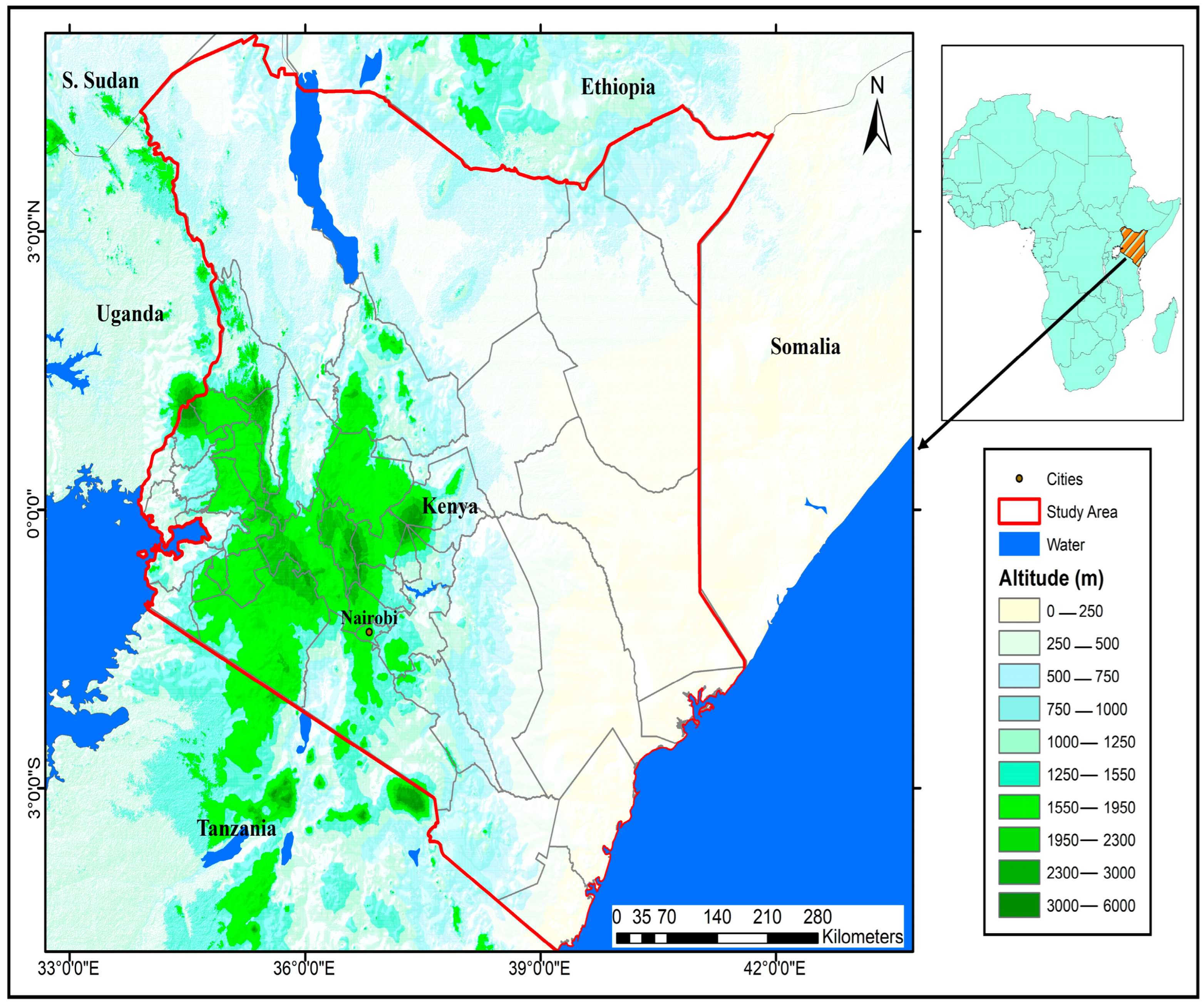
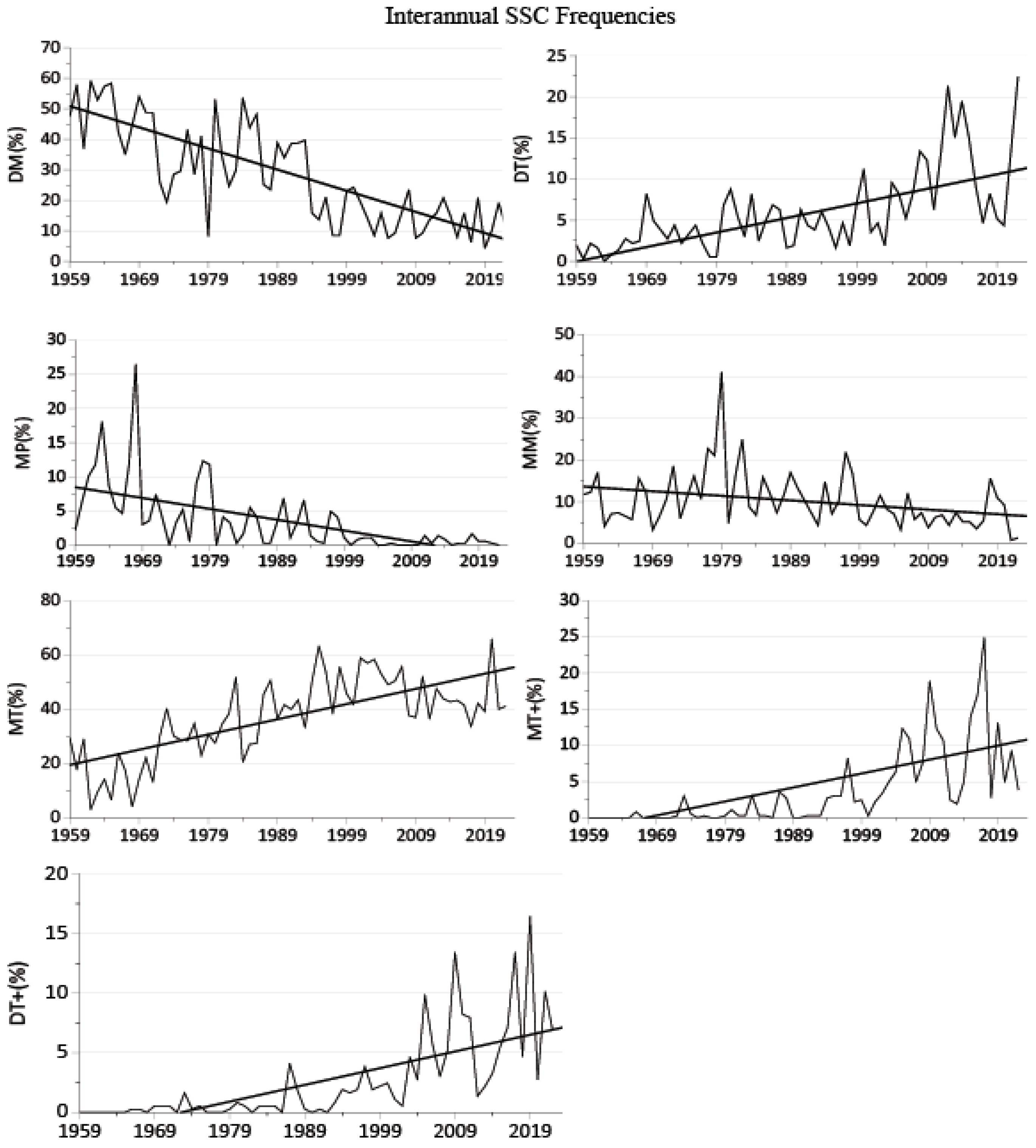



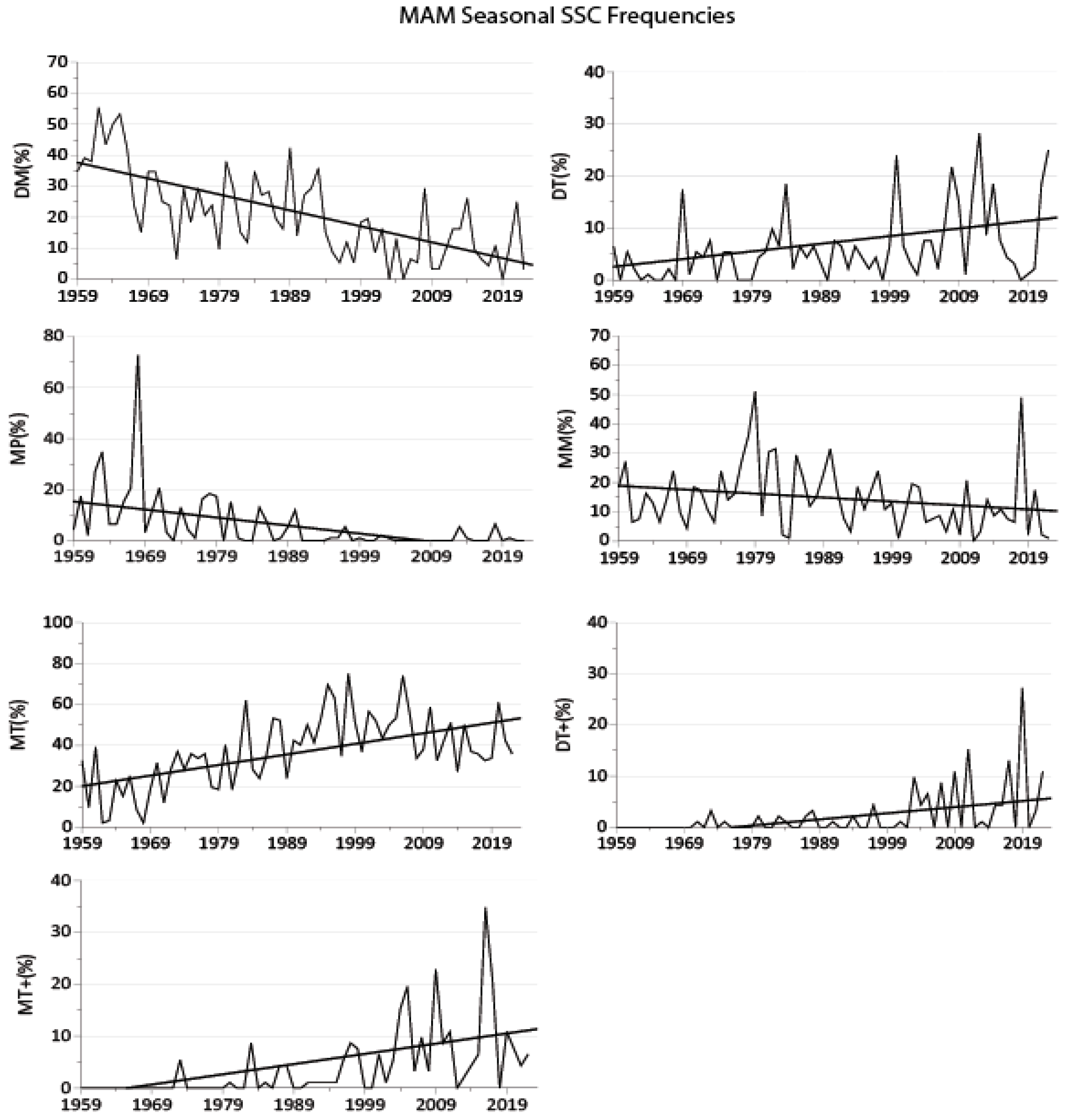
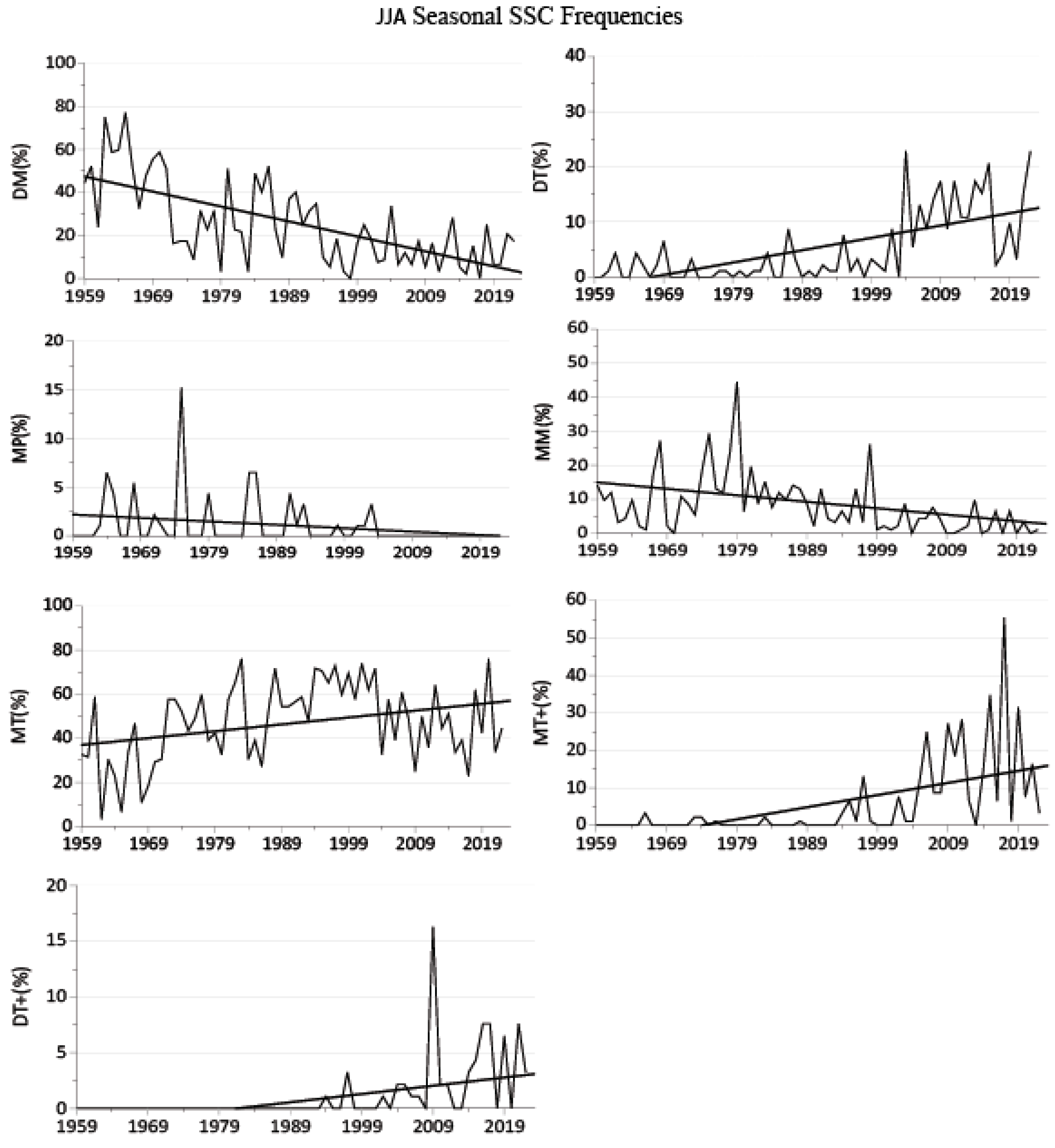
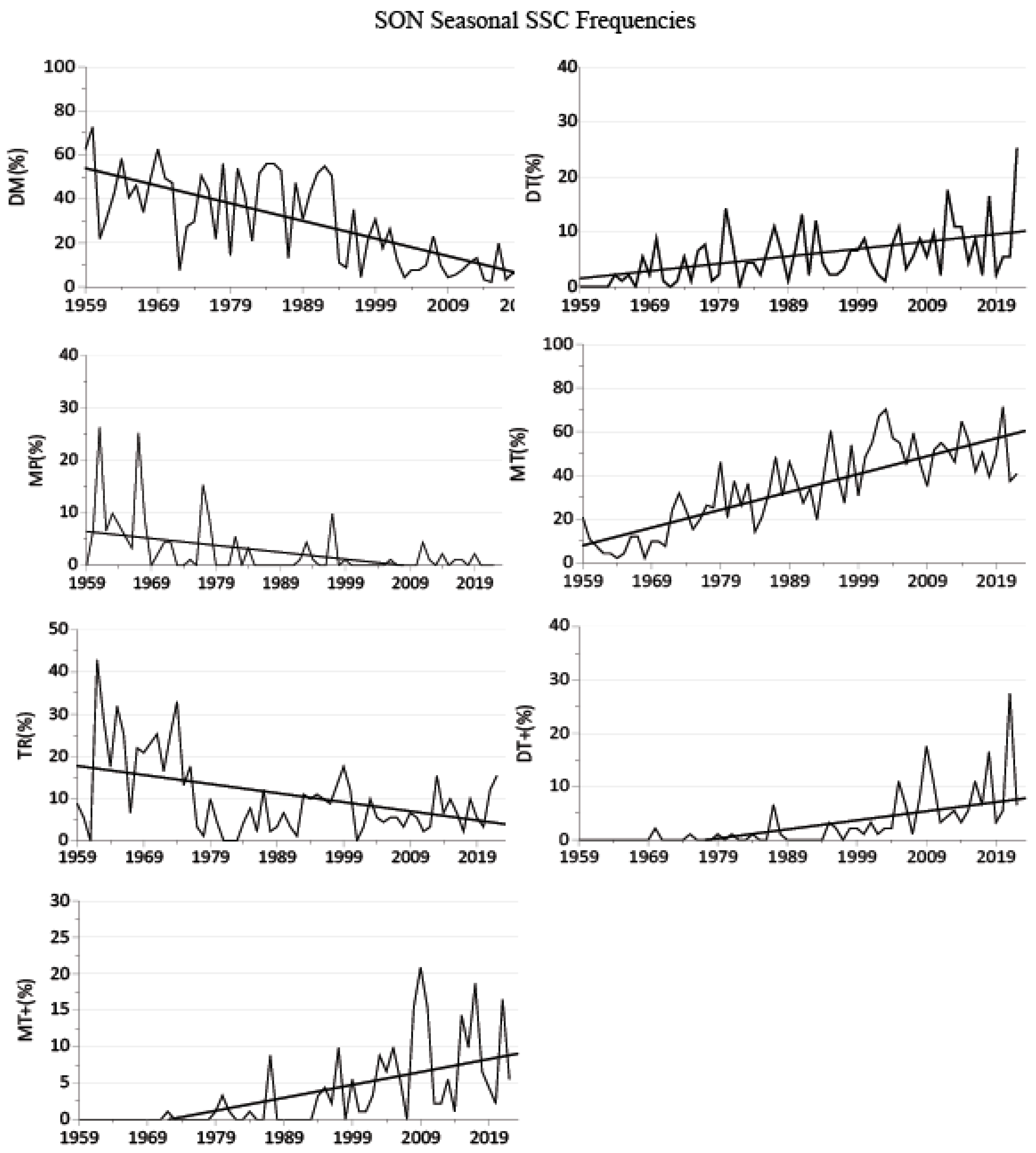
| Town | Region | Temp (°C) | Rainfall (mm) |
|---|---|---|---|
| Mombasa | Coastal | 26.6 | 1034.0 |
| Marsabit | Northern | 27.0 | 513.0 |
| Kitui | Eastern | 25.3 | 696.0 |
| Wajir | Northeastern | 27.9 | 410.0 |
| Nairobi | Central | 18.9 | 913.0 |
| Kericho | Rift Valley | 18.3 | 1654.0 |
| DM | DT | MP | MM | MT | TR | DT+ | MT+ | |
|---|---|---|---|---|---|---|---|---|
| Temperature (°C) | 26–29 | 27–31 | 23–26 | 24–27 | 25–29 | 26–30 | 27–32 | 27–31 |
| Dew Point (°C) | 13–18 | 12–16 | 14–19 | 15–20 | 15–19 | 11–16 | 12–17 | 15–18 |
| Cloud Cover (10 ths) | 4–6 | 3–5 | 7–8 | 6–8 | 5–7 | 3–5 | 3–5 | 4–6 |
| Wind Speed (Km/h) | 7–15 | 7–16 | 6–12 | 7–12 | 7–14 | 7–18 | 11–13 | 10–13 |
| Apparent Temperature (°C) | 26–28 | 27–30 | 24–27 | 24–28 | 26–29 | 26–28 | 27–31 | 26–31 |
| DP | DM | DT | MP | MM | MT | TR | DT+ | MT+ | |
|---|---|---|---|---|---|---|---|---|---|
| January | 0.0 | 39.7 | 14.6 | 3.8 | 5.4 | 27.6 | 8.9 | 4.9 | 1.3 |
| February | 0.0 | 39.6 | 11.4 | 4.3 | 5.5 | 30.5 | 8.7 | 3.0 | 2.7 |
| March | 0.0 | 24.7 | 12.9 | 6.9 | 11.5 | 34.3 | 9.7 | 3.8 | 4.0 |
| April | 0.0 | 14.4 | 7.1 | 6.1 | 17.5 | 44.7 | 10.2 | 2.1 | 3.1 |
| May | 0.0 | 23.1 | 5.8 | 5.8 | 14.7 | 44.9 | 5.7 | 0.8 | 4.9 |
| June | 0.1 | 27.9 | 5.5 | 1.9 | 9.2 | 49.9 | 5.6 | 1.0 | 5.7 |
| July | 0.0 | 23.6 | 5.6 | 0.4 | 8.2 | 56.1 | 6.1 | 0.8 | 5.9 |
| August | 0.0 | 25.3 | 7.3 | 1.0 | 7.4 | 51.9 | 7.2 | 1.6 | 4.9 |
| September | 0.0 | 25.7 | 7.2 | 0.4 | 8.2 | 49.7 | 8.9 | 2.0 | 4.3 |
| October | 0.0 | 29.9 | 10.0 | 2.3 | 11.6 | 33.8 | 12.4 | 3.2 | 3.8 |
| November | 0.0 | 29.5 | 7.8 | 5.7 | 13.6 | 30.1 | 13.3 | 3.5 | 2.1 |
| December | 0.0 | 35.2 | 8.6 | 4.9 | 10.6 | 29.2 | 11.5 | 4.4 | 0.9 |
| Total | 0.0% | 28.2% | 8.6% | 3.6% | 10.3% | 40.3% | 9.0% | 2.6% | 3.6% |
| SSC | DM | DP | DT | MM | MP | MT | TR | MT+ | DT+ |
|---|---|---|---|---|---|---|---|---|---|
| r2 | 0.626 | 0.502 | |||||||
| p | <0.001 | 0.55 | <0.001 | 0.004 | <0.001 | <0.001 | 0.18 | <0.001 | <0.001 |
| DM | DT | MM | MP | MT | TR | MT+ | DT+ | ||
|---|---|---|---|---|---|---|---|---|---|
| DJF | r2 | 0.535 | 0.485 | ||||||
| p | <0.001 | <0.001 | 0.581 | <0.001 | <0.001 | 0.642 | <0.001 | <0.001 | |
| Δ | −7.0 | 3.8 | 0.0 | −1.0 | 4.7 | −0.5 | 0.7 | 1.7 | |
| MAM | r2 | 0.474 | 0.324 | ||||||
| p | <0.001 | 0.002 | 0.016 | <0.001 | <0.001 | 0.829 | <0.001 | <0.001 | |
| Δ | −5.1 | 2.1 | −1.6 | −2.8 | 7.1 | 0.3 | 1.8 | 1.0 | |
| JJA | r2 | 0.108 | |||||||
| p | <0.001 | <0.001 | <0.001 | 0.028 | 0.008 | 1.0 | <0.001 | <0.001 | |
| Δ | −7.2 | 2.4 | −1.6 | −0.1 | 6.9 | −0.2 | 2.8 | 0.5 | |
| SON | r2 | 0.658 | |||||||
| p | <0.001 | <0.001 | 0.315 | 0.001 | <0.001 | 0.025 | <0.001 | <0.001 | |
| Δ | −9.0 | 2.4 | 0.2 | −1.0 | 9.2 | −1.9 | 1.4 | 1.2 |
Disclaimer/Publisher’s Note: The statements, opinions and data contained in all publications are solely those of the individual author(s) and contributor(s) and not of MDPI and/or the editor(s). MDPI and/or the editor(s) disclaim responsibility for any injury to people or property resulting from any ideas, methods, instructions or products referred to in the content. |
© 2024 by the authors. Licensee MDPI, Basel, Switzerland. This article is an open access article distributed under the terms and conditions of the Creative Commons Attribution (CC BY) license (https://creativecommons.org/licenses/by/4.0/).
Share and Cite
Alaso, D.C.; Senkbeil, J.C.; Sheridan, S.C. Development of a Spatial Synoptic Classification Scheme for East Africa with a Focus on Kenya. Climate 2024, 12, 133. https://doi.org/10.3390/cli12090133
Alaso DC, Senkbeil JC, Sheridan SC. Development of a Spatial Synoptic Classification Scheme for East Africa with a Focus on Kenya. Climate. 2024; 12(9):133. https://doi.org/10.3390/cli12090133
Chicago/Turabian StyleAlaso, Daniella C., Jason C. Senkbeil, and Scott C. Sheridan. 2024. "Development of a Spatial Synoptic Classification Scheme for East Africa with a Focus on Kenya" Climate 12, no. 9: 133. https://doi.org/10.3390/cli12090133
APA StyleAlaso, D. C., Senkbeil, J. C., & Sheridan, S. C. (2024). Development of a Spatial Synoptic Classification Scheme for East Africa with a Focus on Kenya. Climate, 12(9), 133. https://doi.org/10.3390/cli12090133





